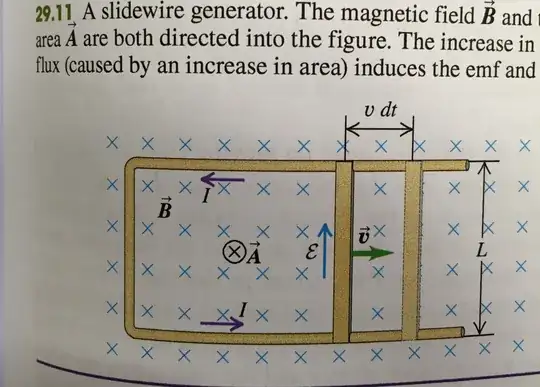The general convention for magnetic field lines going into a plane/page is $\times\,\times\,\times$ (see for example Sears and Zemansky's University Physics with Modern Physics" 14th edition by Hugh D. Young and Roger A. Freedman (2015), or "University Physics" - Revised Edition, by Harris Benson (1996) orFundamentals of Physics" 6th edition by Halliday, Walker and Resnick (2001).)
Since the rod PQ is moving to the left, the magnetic flux into the page that is enclosed by the rectangle with corners PQRS is decreasing. On account of conservation of energy Lenz' law acts to counter act the decreasing magnetic flux. The induced EMF produced to counteract the decreasing magnetic flux $\Phi_B$ is
$$
{\cal E} = -\frac{d\Phi_{B}}{dt}\,.
$$
Associated with the induced EMF ${\cal E}$ is an induced current $I_{\rm ind}$. The current $I_{\rm ind}$ is directed clockwise around the rectangle PQRS as you look at it, i.e. the induce current flows in the direction of P to Q and Q to R and R to S and S to Q, contrary to the suggestion in the diagram provided from the book that the OP references.
The magnetic field associated with this current is ${\bf B}_{\rm ind}$. It is directed into the page and this counteracts the decrease in magnetic flux caused by the rod moving to the left.
If the rod in the above figure moved to the right with velocity ${\bf v}$ the direction of current in the diagram above would be correct. This is confirmed by Figures 29.11, 29.12, and 29.13 (b) in Sears and Zemansky's ``University Physics with Modern Physics" 14th edition by Hugh D. Young and Roger A. Freedman (2015) which I have right in front of me. I would like to share the figures but I think this might infringe copyright rules. In any case I think if one does a bit of searching around the internet or checking out other physics textbooks one will find that what I have written above is correct.
Edit: I have decided to add Figure 29.11 from the text by Young and Freedman.

Edit 2: The Figure 29.11 shows for a bar moving to the right that the magnetic flux into the page increases. A counter-clockwise EMF ${\cal E}_{c-c}$ is needed to produce a counter-clockwise induced current which will produce an induced magnetic field that comes through the loop and out of the page and counter acts the increase in magnetic flux into the page caused by the bar moving to the right.

